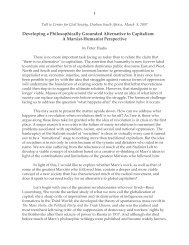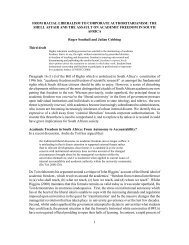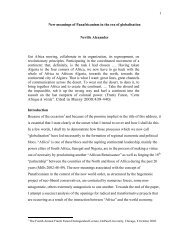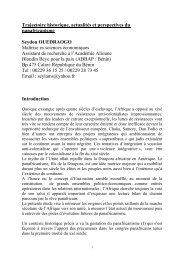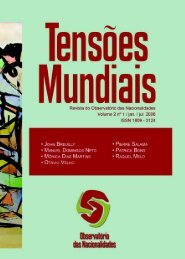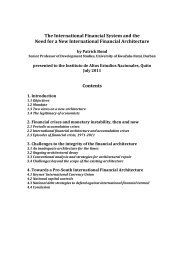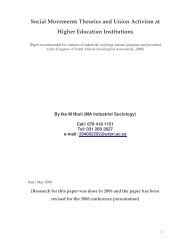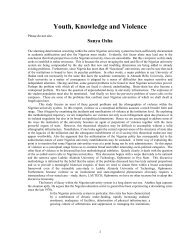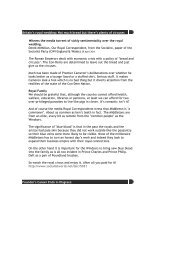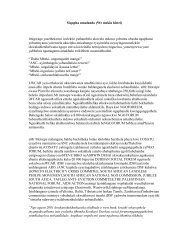The Cape of Good Dope? - Centre for Civil Society - University of ...
The Cape of Good Dope? - Centre for Civil Society - University of ...
The Cape of Good Dope? - Centre for Civil Society - University of ...
You also want an ePaper? Increase the reach of your titles
YUMPU automatically turns print PDFs into web optimized ePapers that Google loves.
the movement to do something about those grievances. (Buechler<br />
2000:41)<br />
Pagad describes itself as a ‘broadly based multi-faith movement’, that is ‘non-aligned,<br />
non-affiliated to any political movement’ (Interview AR, October 2003). Despite this,<br />
the label, ‘Muslim movement’ has stuck. Part <strong>of</strong> this lay in the fact that ‘its rhetoric<br />
and grassroots support expressed unmistakable Islamic characteristics. Its marches,<br />
scarves and slogans evoked scenes from international Islamic movements’ (Tayob<br />
1996:30). As Jeppie points out ‘Pagad members would march - <strong>for</strong> the occasion, men<br />
in kaffiyehs, women in black hijab - through the main streets to the homes <strong>of</strong> alleged<br />
drug dealers. <strong>The</strong>y marched after late night mass meetings at mosques, followed by<br />
prayers and dhikirs, so that the marches could be physically and collectively prepared<br />
to “confront the enemy”’ (Jeppie 2000:227).<br />
<strong>The</strong> fact that the meeting place was outside the mosque (most <strong>of</strong>ten the Gatesville<br />
Mosque), rein<strong>for</strong>ced the label, ‘Muslim movement’. Some have taken on this issue <strong>of</strong><br />
Muslim as a positive. Na’eem Jeenah saw Pagad continuing past traditions: ‘From the<br />
arrival <strong>of</strong> Muslims on these shores, Muslims have been engaged in a struggle against<br />
oppression and dictatorship . . . Muslims have striven with might to achieve justice<br />
here… the Pagad phenomenon is just a continuation <strong>of</strong> this heritage’ (Jeenah 1996:18).<br />
<strong>The</strong> language <strong>of</strong> the meetings was dominated by an Islamic discourse. ‘Quranic verses<br />
<strong>of</strong> struggle and slogans, introduced first by the Muslim Youth Movement from Egypt<br />
and Pakistan, reverberated at the end <strong>of</strong> Pagad meetings. More directly, reflecting the<br />
founder <strong>of</strong> Qibla, Achmat Cassiem’s, Islamist version, the Quranic verse appealing <strong>for</strong><br />
unity, “Hold on fast to the rope <strong>of</strong> God and be not divided” (3:103), was recited at the<br />
end <strong>of</strong> every meeting with members holding hands over their heads . . . Unity,<br />
togetherness and standing up <strong>for</strong> truth and justice charged and overwhelmed Pagad<br />
meetings. <strong>The</strong> atmosphere and motivation was certainly and unmistakably Islamist’<br />
(Tayob 1996:32).<br />
Initially, the slogans at meetings were drawn from the days <strong>of</strong> the liberation struggle:<br />
‘Kill the drug merchant, kill!’ drew on the ANC Youth League president, Peter<br />
Mokaba’s, ‘Kill the Boer, kill the farmer’, and the PAC slogan, ‘One Settler, One<br />
Bullet!’ But this also in time got an Islamic inflection captured in the slogan ‘One<br />
Solution, Islamic Revolution’. Statements by leadership also reflected Islamic<br />
orientation. Witness the words <strong>of</strong> Salie Abader, the Pagad security chief who faced<br />
charges <strong>of</strong> killing Rashaad Staggie: ‘Whether you have a legal or illegal firearm, they<br />
(the gangsters and drug dealers) must be removed. If you take a firearm and see a<br />
merchant, don’t tell them they are rubbish or criminals. Call out the name <strong>of</strong> God and<br />
let Allah guide the bullet’ (<strong>Cape</strong> Argus, 14/12/2000).<br />
<strong>The</strong> “global” also impacted on identity. One <strong>of</strong> the ways <strong>of</strong> understanding this impact<br />
is through images portrayed in the media.<br />
Gabeba Baderoon provides some interesting insights in analysing stories on Pagad in<br />
South African newspapers in the week 5-12 August 1996. One image was particularly<br />
striking. On 5 August 1996, the Argus story on Pagad was accompanied in the right<br />
hand corner <strong>of</strong> the page by ‘a small picture <strong>of</strong> an unidentified man whose face is<br />
masked by a scarf, known in <strong>Cape</strong> Town as a “Palestinian” or “Arafat” scarf. In<br />
9



